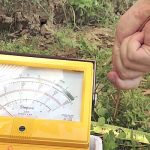Literally, the difference is actually the number of points of contact with the soil. More specifically, these commonly used terms refer to dead earth, fall of potential, and Wenner method tests, respectively. In the dead earth method, contact is made at just two points: the ground electrode under test and a convenient reference ground, such as the water pipe system or a metal fence post.
In the fall of potential method, a genuine ground tester makes contact via the test electrode, plus the current and potential probes. With the Wenner method, no ground electrode is involved, but rather the independent electrical properties of the soil itself can be measured using a four-probe setup and a recognized standard procedure.
Can’t I simply make a measurement to a reference ground?
This common method often uses an instrument other than a dedicated ground tester. It is referred to as the dead earth method because the reference ground is only being used for the test and is not normally part of an electrical system. It can be the water pipes, a metal fence post, or even a rod driven just for the test.
The method is popular because of its ease and generality, but is not recommended. Since the reference ground happens to be located by a combination of convenience and chance, it is only a matter of luck if the soil resistance to it actually represents the true electrical ground resistance.


